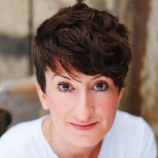Last Ones Left Alive
Review
Last Ones Left Alive
If I had only a few seconds to pitch this novel to an editor or movie producer, I’d say something like: “Post-apocalyptic zombie fiction, Irish style: 'The Walking Dead' meets Emma Donoghue or Edna O’Brien.”
LAST ONES LEFT ALIVE, the first novel by Dublin-based journalist Sarah Davis-Goff, is squarely in the popular zombie genre. It is also beautifully written, with sentences that have the characteristic lilt of her homeland (“so you would”; “so they do”; “on I go”). The book is very, very Irish, from the characters’ names (Maeve, Muireann, Cillian, Aodh --- no idea how to pronounce that) to the emerald-isle green of the post-industrial landscape, to the mix of sentiment and grit.
In this perilous future world, life is a battle between humans and shrake, the flesh-eating undead that roam the country. Once bitten, of course, you become a zombie: That’s how they reproduce. Orpen, the narrator, is a teenage girl named after an early-20th-century Irish artist who painted scenes of World War I --- an earlier apocalypse. (Mind you, I had to look him up.) We first meet her on a deserted road, accompanied by a dog named Danger (symbolic, much?) and an unconscious woman, half human, half shrake, in a wheelbarrow.
The woman, it turns out, is Maeve, Orpen’s mother’s lover (got that?) and one of the two people who raised her on Slanbeg, a zombie-free island off the Irish coast. Davis-Goff builds considerable suspense with a narrative that alternates between this strange-but-idyllic past and the taut, shrake-threatened present.
"I don’t think it’s an accident that the book’s best scenes evoke universal experience.... Davis-Goff’s action scenes are consistently cinematic, visceral, thrilling..."
Orpen is taught by her mother to read and write, and in addition she educates herself through books and papers and artifacts found in deserted cottages on the island. She is ever hungrier “to know more about how it was when the world was whole,” to go with Mam and Maeve on their scavenging runs to the mainland.
But at age seven, Orpen’s life changes. Her birthday gift is a set of knives; her existence from then on will be one big lesson in survival --- building stamina, honing reflexes, becoming intimate with weapons, ultimately being prepared to kill. Both her mother and Maeve train her, but their methods are different: “Mam fights with humor and grace and kindness. She makes me love the fight. Maeve is cold and hard and unfair.... She makes me good at it.”
The years pass. Mam is bitten and turns into a shrake; they have to put her to death. But when Maeve is bitten, too, Orpen refuses to kill her, to lose this last link with home. Instead, she carts her along when she leaves Slanbeg for the mainland. She’s not sure if other humans are still alive, in Ireland or the world. She is conditioned, in any case, to fear people, men in particular.
Thus, when she encounters a man, woman and child on the road, at first Orpen has no idea how to behave; she knows only how to fight. In time, these seriously decent people, escapees from the city, begin to win her over. The aspect of the book that does not work for me, however, is Orpen’s growing physical attraction to the man, Cillian. Yes, she’s lonely and naïve and hormonally vulnerable, yet this quasi-romance seems to me too opposed to her training, too sentimental, too convenient.
LAST ONES LEFT ALIVE doesn’t break new ground in the zombie apocalypse genre. Even someone like me, who loves a good dystopia (THE GIRL WITH ALL THE GIFTS, STATION ELEVEN) but isn’t particularly conversant with the vamp/zombie universe, finds major echoes of other novels, TV series and films in this book. And I wish Davis-Goff wasn’t so vague about why and how the world got this way. I kept waiting for some real backstory on the apocalypse, but it doesn’t arrive.
I think that’s because the author’s interests lie elsewhere. Constructing a credible future society isn’t her focus; rather, she wants to show how basic human emotions, needs and habits persist in an extreme situation. I don’t think it’s an accident that the book’s best scenes evoke universal experience. The ugly death of Orpen’s mother --- she morphs into a shrake --- summons the horror of any maternal death, the transformation of the person who bore you into an alien creature struggling to survive. Similarly, the girl’s desire to leave home and plunge into the uncertainty of life on the mainland is a more hazardous version of any adolescent rebellion.
Orpen has long been obsessed with the mysterious Phoenix City, former home of Mam and Maeve. It’s also where the trio she meets on the road once lived, and they drop ominous hints about what it’s like and why they left (the fact that all three are illiterate is a troubling sign). Yet Orpen is dying to go there. She’s drawn by cryptic references to fighting women known as banshees --- the banshee being, in Irish mythology, a female spirit who heralds death --- and these amazons loom large in her imagination.
But are they mythical or real? Toward the end of this short book, there is a tremendous battle between human and shrake --- Davis-Goff’s action scenes are consistently cinematic, visceral, thrilling --- and Orpen discovers the truth at last. Then, to my chagrin, the story simply comes to a halt. We last see Orpen on her way to the city, and while there is no explicit promise of a sequel, you can be certain that this warrior girl’s odyssey isn’t over.
Reviewed by Katherine B. Weissman on September 6, 2019
Last Ones Left Alive
- Publication Date: January 19, 2021
- Genres: Dystopian Fiction, Fiction, Post-Apocalyptic Fiction
- Paperback: 288 pages
- Publisher: Flatiron Books
- ISBN-10: 1250235235
- ISBN-13: 9781250235237




